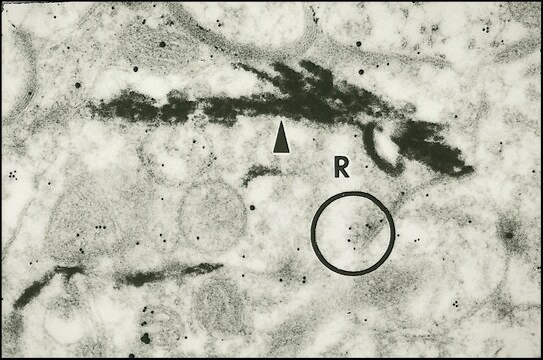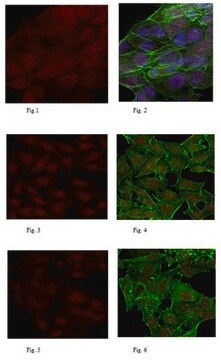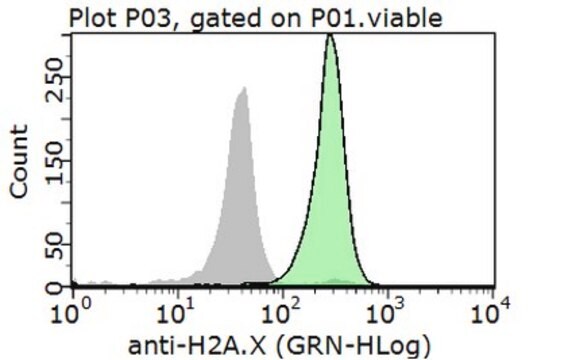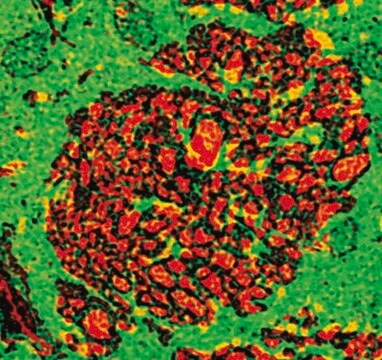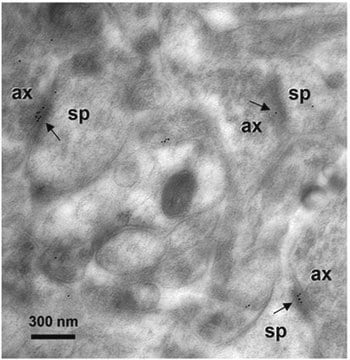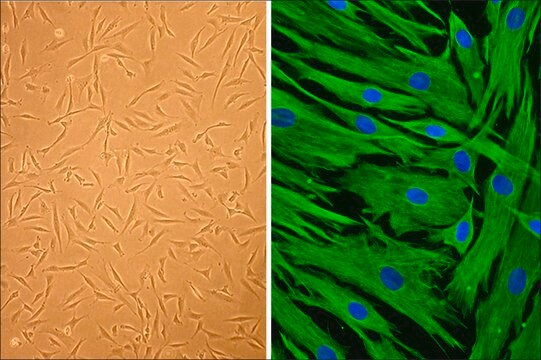MAB5304
Anti-Glutamate Antibody
Chemicon®, from mouse
About This Item
Empfohlene Produkte
Biologische Quelle
mouse
Antikörperform
purified antibody
Antikörper-Produkttyp
primary antibodies
Klon
monoclonal
Speziesreaktivität
rat
Hersteller/Markenname
Chemicon®
Methode(n)
immunohistochemistry: suitable
Isotyp
IgM
Versandbedingung
dry ice
Posttranslationale Modifikation Target
unmodified
Spezifität
The cross-reactivities were determined using an ELISA test by competition experiments with the following compounds:
Compound Cross-reactivity
Glutamate-G-BSA 1
Aspartate-G-BSA 1/100,000
GABA-G-BSA 1/100,000
Glutamate 1/100,000
Abbreviations:
(G) Glutaraldehyde
(BSA) Bovine Serum Albumin
NOTE: Antibody reactivity REQUIRES glutaraldehyde fixation thus some glutaraldehyde (0.5%-2.0%) needs to be included in the tissue fixation procedure inorder for the proper reactivity.
Immunogen
Anwendung
Neurowissenschaft
Neurotransmitter & Rezeptoren
Neuroinflammation & Schmerz
Optimal working dilutions must be determined by end user.
PROTOCOL for Glutamate Detection by Immunohisto/cytochemistry. Example for a rat brain.
1. SOLUTIONS TO BE PREPARED - Solution must be prepared as needed.
Solution A: 0.1M cacodylate, 10g/L sodium metabisulfite, pH 6.2.
Solution B: 0.1M cacodylate, 10g/L sodium metabisulfite, 3-5% glutaraldehyde, pH 7.5.
2. RAT PERFUSION - The rat is anaesthetized with sodium pentobarbital or Nembutal and perfused intracardially through the aorta using a pump with Solution A (30 mL): 150-300 mL/min, Solution B (500 mL): 150-300 mL/min.
3. POST FIXATION: 15 to 30 minutes in Solution B, then 4 soft washes in 0.05M Tris with 8.5 g/L sodium metabisulfite, pH 7.5 (Solution C) .
4. TISSUE SECTIONING: Vibratome or cryostat sections can be used.
5. REDUCTION STEP: Sections are reduced with Solution C containing 0.1M sodium borohydride for 10 minutes. The sections are washed 4 times in solution C without sodium borohydride.
6. APPLICATION OF GLUTAMATE ANTIBODY: Use a final dilution of 1:2,500-1:10,000 in Solution C containing 0.1% Triton X100 and 2% non-specific serum. Incubate 12 sections per 2 mL diluted antibody overnight, +2-8°C. Then wash the sections three times for 10 minutes each in Solution C. (Note that the antibody may be usable at a higher dilution. This should be explored to minimize the possibility of high background. Additionally, note that a change in the buffering system as indicated in the protocol may change the background and antibody recognition). The specific reaction is then revealed by PAP procedure.
7. SECOND ANTIBODY: Incubate the sections with a 1:50 to 1:200 dilution of goat anti-mouse in Solution B containing 1% non-specific serum for either 3 hrs at 20°C or 1-2 hr at 37°C. Then wash the sections, 3 times, for 10 minutes each with Solution C.
8. PAP: Incubate the sections with the appropriate dilution of peroxidase anti-peroxidase (for free floating method) in Solution C for 1-2 hours at 37°C. Then wash sections 3 times for 10 min each in solution C.
9. VISUALIZATION: The antigen-antibody complexes are visualized using DAB-4-HCl (25 mg/100 mL) (or other chromogen) in 0.05M Tris and filtrated; 0.05% hydrogen peroxide is added. Incubate the sections for 10 minutes at room temp. Stop the reaction by transferring the sections to 5 mL 0.05M Tris. Mount sections on chrome-alum coated slides. Dry overnight at 37°C. Rehydrate sections using conventional histological procedures. Coverslip using rapid mounting media.
For research use only; not for use as a diagnostic.
Physikalische Form
Lagerung und Haltbarkeit
Rechtliche Hinweise
Haftungsausschluss
Sie haben nicht das passende Produkt gefunden?
Probieren Sie unser Produkt-Auswahlhilfe. aus.
Lagerklassenschlüssel
12 - Non Combustible Liquids
WGK
WGK 2
Flammpunkt (°F)
Not applicable
Flammpunkt (°C)
Not applicable
Analysenzertifikate (COA)
Suchen Sie nach Analysenzertifikate (COA), indem Sie die Lot-/Chargennummer des Produkts eingeben. Lot- und Chargennummern sind auf dem Produktetikett hinter den Wörtern ‘Lot’ oder ‘Batch’ (Lot oder Charge) zu finden.
Besitzen Sie dieses Produkt bereits?
In der Dokumentenbibliothek finden Sie die Dokumentation zu den Produkten, die Sie kürzlich erworben haben.
Unser Team von Wissenschaftlern verfügt über Erfahrung in allen Forschungsbereichen einschließlich Life Science, Materialwissenschaften, chemischer Synthese, Chromatographie, Analytik und vielen mehr..
Setzen Sie sich mit dem technischen Dienst in Verbindung.